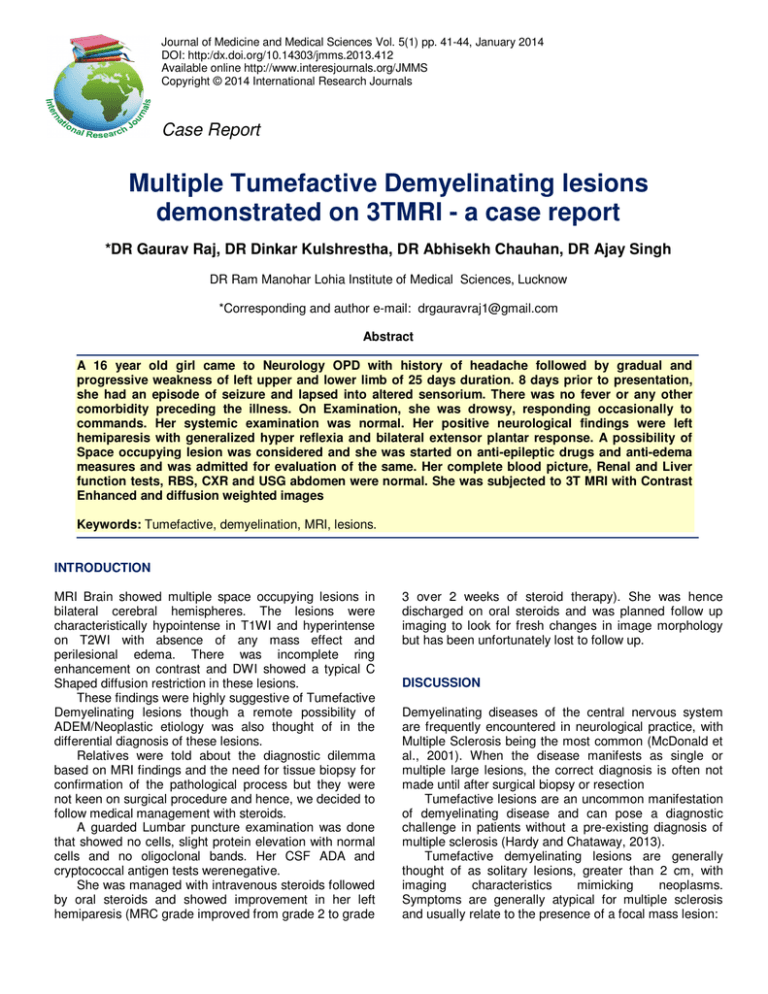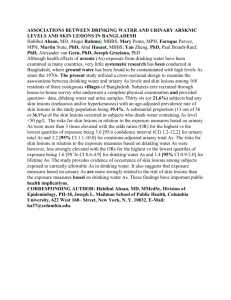Document 14233353
advertisement

Journal of Medicine and Medical Sciences Vol. 5(1) pp. 41-44, January 2014 DOI: http:/dx.doi.org/10.14303/jmms.2013.412 Available online http://www.interesjournals.org/JMMS Copyright © 2014 International Research Journals Case Report Multiple Tumefactive Demyelinating lesions demonstrated on 3TMRI - a case report *DR Gaurav Raj, DR Dinkar Kulshrestha, DR Abhisekh Chauhan, DR Ajay Singh DR Ram Manohar Lohia Institute of Medical Sciences, Lucknow *Corresponding and author e-mail: drgauravraj1@gmail.com Abstract A 16 year old girl came to Neurology OPD with history of headache followed by gradual and progressive weakness of left upper and lower limb of 25 days duration. 8 days prior to presentation, she had an episode of seizure and lapsed into altered sensorium. There was no fever or any other comorbidity preceding the illness. On Examination, she was drowsy, responding occasionally to commands. Her systemic examination was normal. Her positive neurological findings were left hemiparesis with generalized hyper reflexia and bilateral extensor plantar response. A possibility of Space occupying lesion was considered and she was started on anti-epileptic drugs and anti-edema measures and was admitted for evaluation of the same. Her complete blood picture, Renal and Liver function tests, RBS, CXR and USG abdomen were normal. She was subjected to 3T MRI with Contrast Enhanced and diffusion weighted images Keywords: Tumefactive, demyelination, MRI, lesions. INTRODUCTION MRI Brain showed multiple space occupying lesions in bilateral cerebral hemispheres. The lesions were characteristically hypointense in T1WI and hyperintense on T2WI with absence of any mass effect and perilesional edema. There was incomplete ring enhancement on contrast and DWI showed a typical C Shaped diffusion restriction in these lesions. These findings were highly suggestive of Tumefactive Demyelinating lesions though a remote possibility of ADEM/Neoplastic etiology was also thought of in the differential diagnosis of these lesions. Relatives were told about the diagnostic dilemma based on MRI findings and the need for tissue biopsy for confirmation of the pathological process but they were not keen on surgical procedure and hence, we decided to follow medical management with steroids. A guarded Lumbar puncture examination was done that showed no cells, slight protein elevation with normal cells and no oligoclonal bands. Her CSF ADA and cryptococcal antigen tests werenegative. She was managed with intravenous steroids followed by oral steroids and showed improvement in her left hemiparesis (MRC grade improved from grade 2 to grade 3 over 2 weeks of steroid therapy). She was hence discharged on oral steroids and was planned follow up imaging to look for fresh changes in image morphology but has been unfortunately lost to follow up. DISCUSSION Demyelinating diseases of the central nervous system are frequently encountered in neurological practice, with Multiple Sclerosis being the most common (McDonald et al., 2001). When the disease manifests as single or multiple large lesions, the correct diagnosis is often not made until after surgical biopsy or resection Tumefactive lesions are an uncommon manifestation of demyelinating disease and can pose a diagnostic challenge in patients without a pre-existing diagnosis of multiple sclerosis (Hardy and Chataway, 2013). Tumefactive demyelinating lesions are generally thought of as solitary lesions, greater than 2 cm, with imaging characteristics mimicking neoplasms. Symptoms are generally atypical for multiple sclerosis and usually relate to the presence of a focal mass lesion: 42 J. Med. Med. Sci. Pre Contrast T1 and T2 Axial Images showing Bilateral Multiple Lesionshypointense on T1 and hyperintense on T2 without significant mass effect and absence of cortical involvement Post contrast T1 axial image showing characteristic incomplete ring enhancement Gaurav et al. 43 T2 FLAIR axial image showing iso to hyper intense lesions without any perifocal edema Diffusion weighted images showing C shaped ring diffusion restriction in lesions focal neurologic deficit, seizure, or aphasia (Fallah et al., 2010). Distinguishing tumefactive lesions from other etiologies of intracranial space occupying lesions is essential to avoid inadvertent surgical or toxic chemotherapeutic intervention. Tumefactive demyelinating lesions represent an intermediate lesion between those typically seen with 44 J. Med. Med. Sci. multiple sclerosis and acute disseminated encephalomyelitis. Pathologically, these lesions are indistinguishable from typical multiple sclerosis plaques and are characterized by infiltrating foamy macrophages filled with luxol fast blue/periodic acid-Schiff–positive myelin breakdown products intimately admixed with reactive multipolar astrocytes, some exhibiting multiple micro nucleoli (Creutzfeldt cells).Necrosis is very uncommon but may be seen in rapidly evolving lesions (Donev and Scheithauer, 2010). Generally, tumefactive demyelinating lesions are defined as a solitary intracranial lesion larger than 2.0 cm in diameter, but multiple lesions are not uncommon.Tumefactive demyelinating lesions tend to be circumscribed lesions with little mass effect or vasogenic edema. They typically involve the supratentorial compartment and are centered within the white matter, although they may extend to involve the cortical gray matter. Approximately half of tumefactive demyelinating lesions have pathologic contrast enhancement, usually in the form of ring enhancement. Commonly the enhancement patterns will be in the form of an open ring, with the incomplete portion of the ring on the gray matter side of the lesion. The enhancing portion of the ring is believed to represent the leading edge of demyelination and thus favors the white matter side of the lesion. The central nonenhancing core represents a more chronic phase of the inflammatory process (Hardy and Chataway, 2013; Curtis et al., 2004; Martha et al., 2011). Our patient had radiological evidence of tumefactive MS and showed good response to steroids. We wanted to see the progression of these lesions on follow up scans but as the patient did not turn up, the same could not be achieved. CONCLUSION Tumefactive demyelinating lesions prove to be a diagnostic dilemma in clinical practice. The MRI appearance of these lesions can aid in relatively reliable diagnosis. Perhaps the most useful diagnostic tool is the open ring of enhancement and relatively sparse mass effect and edema associated with these often-sizeable lesions. REFERENCES Aria F, Sarfaraz B, Shanil E, John EP, Neilank K. Jha (2010). Tumefactive demyelinating lesions: a diagnostic challenge Can. J. Surg. February; 53(1): 69–70 Hardy TA, Chataway J (2013).Tumefactive demyelination: an approach to diagnosis and management. J Neurol Neurosurg Psychiatry. Sep; 84(9):1047-53. Kaeser MA, Scali F, Lanzisera FP, Glenn A. Bub, and Norman W (2011). Kettner Tumefactive multiple sclerosis: an uncommon diagnostic challengen. J Chiropr Med. March; 10(1): 29–35 Kliment D, Bernd WS (2010). Pseudoneoplasms of the Nervous System Arch Pathol Lab Med.;134:404–416 Curtis AG, Scott SB, Charles L (2004). The MRI Appearance of Tumefactive Demyelinating Lesions. American Journal of Roentgenology. 182: 195-199 McDonald WI, Compston A, Edan G, et al. ? provide others authors names (2001) Recommended diagnostic criteria for multiple sclerosis: guidelines from the International Panel on the Diagnosis of multiple sclerosis. Ann Neurol. 50: 121–7.2. How to cite this article: Raj G, Kulshrestha D, Chauhan A, Singh A (2014). Multiple Tumefactive Demyelinating lesions demonstrated on 3TMRI - a case report. J. Med. Med. Sci. 5(2):41-44




